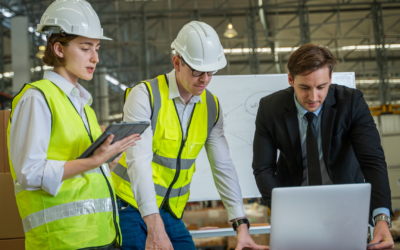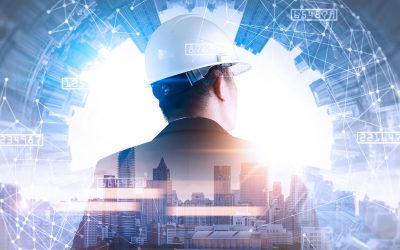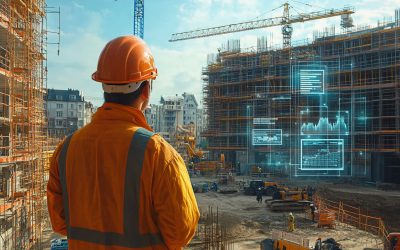How to improve health & safety in the construction industry using AI
Subscribe to our newsletter
Get the latest updates, trends and news directly in your inbox.
Finding a better way to manage complexity
This begs the question – why has construction site safety improved so little over the past few decades? The answer is… complexity. Construction projects are incredibly complex systems of interactions, interdependencies, and relationships. Some people refer to the construction sector as the most complex undertaking of any industry.
In construction, safety is everyone’s responsibility – the workers, managers, and leaders, as well as regulators. However, our human brains have a limited capacity to manage and understand complexity, and we struggle to process large amounts of information simultaneously. We also bring a number of cognitive biases to work, like underestimating risks or overestimating the effectiveness of our own mitigation strategies.
You might think that relying on highly experienced safety managers is the answer. However, even the most experienced safety managers learn from just a hundred or so incidents in their entire careers. Wisdom and good intentions are not enough to propel the industry forward. In reality, with so many layers of complexity involved, it’s almost impossible for humans to recognise all potential hazards and have accurate risk assessments.
This is where artificial intelligence (AI) helps to play its role in making construction workplaces safer. AI’s core strength is processing vast amounts of data quickly and finding meaningful patterns. Imagine using information such as site conditions, worker experience, and project size to help predict the likelihood and severity of future safety issues. The more construction businesses collect and use digitalised solutions to create insights, keeping workers safe will become easier and easier.
Getting smart about improving safety, precisely
Precision medicine is an emerging treatment philosophy and considers the variability of a person’s genes, environment, and lifestyle. The approach allows doctors to predict which prevention strategies will work more effectively in different groups of people. Precision agriculture is helping to grow plants and increase their development using 80 percent fewer nutrients. Precision safety, incorporating AI, could assess the many complex construction site variables, help teams select the best preventative strategies and interventions and make job sites safer.

Research demonstrates AI’s power and potential
Research labs around the world are starting to explore and document the benefits of AI. At the University of Colorado, 24 researchers used a list of nearly 5,300 injury reports, gathered from 470 contractors, representing millions of work hours. Based on 80 input variables, researchers could skilfully predict the type of injury and the body part affected in construction incidents.
In another study conducted in Singapore, a prominent contractor provided data from 27 construction projects, including 785 monthly safety inspection records. Based on 13 input variables, the algorithm predicted the occurrence and severity of site accidents with a high level of reliability. Yes, the research is new and somewhat incomplete. However, it demonstrates the power and possibilities of AI.
It all starts with the data
As more construction businesses use digital solutions to collect safety data over time, it will become easier to analyse trends, look for correlations, and identify potential problems.
A strong AI foundation starts with gathering data at the project level. Examples include the type of construction project, ownership model, project stage, size of the workforce, and cost. It is also important to understand an organisation’s safety record, considering safety inspection results and past incidents.
When an incident occurs, AI can track and learn from task characteristics such as:
- a detailed and precise description of what happened
- an overview of the site conditions
- the exact location
- the number of people and work involved
- equipment used or located nearby
- any source of energy (e.g. electricity)
AI can also collect task execution information to explain what happened, including:
- the level of compliance with work instructions
- the position of any injured person/people, including body position and movements involved
- work permit content (if relevant)
Employee specifics will help provide additional meaning, including:
- the worker, his or her age, and experience
- safety training and record
- qualifications and education
- particular state before the incident (body temperature, blood pressure, etc)
Documenting outcomes helps to complete the picture by outlining:
- the type of incident
- the type of injury(ies)
- anything else that is relevant

Pulling it all together
Now let’s take the information outlined in this article and apply it to a fictional AI solution, SafetyAI. SafetyAI is helping a construction firm understand which combination of factors is most likely to lead to an incident in the future.
Imagine the solution, which includes a precision safety algorithm, being switched to prediction mode. With this setting activated, SafetyAI is primed to determine incident risks, their likelihood, immediate cause, severity, and possible injuries. With the right level of preparedness, incidents can be anticipated, mitigated, and at best, avoided altogether.
To optimise SafetyAI, the construction business prepares and runs routines for the week ahead. With a high degree of accuracy, managers are informed of the most likely incidents, given the site conditions, and expected work packages. Managers also receive suggestions for remedial action and specific directions when appropriate.
This helps site leaders discuss risks during pre-job workplace safety meetings, reinforce targeted safety measures, and suggest extra training and supervision support. It also means work can be reassigned to better-suited workers, and if necessary, for work packages to be redesigned to decrease risks.
SafetyAI monitors the construction site in real time, using live data. The changing conditions (team- and site-specific) can be continuously fed into the algorithm for analysis and action.
Consider it is 11am on a hot August day, and team members are working at height. Team member vital signs are monitored to manage worker safety. A worker becomes dizzy due to his rising body temperature, and he is at risk of a fall. SafetyAI alerts the worker and site team to the danger so they can act.
Using AI with other safety technology
Real-time data can be entered manually into SafetyAI or automatically via sensors to measure rain, light, or heat, to name just a few.
SafetyAI can also capture data. Imagine that computerised vision could identify workers not wearing hard hats or safety harnesses or spot the lack of safety rail guards or missing fall-protection systems.
What about the possibility of using a ‘guardian angel’ drone hovering above team members to help with high-risk or difficult work? The drone could be moved in place just before work commences to check parameters, prompt the worker with safety questions, and give instructions via an earplug. The drone would monitor the worker’s status and the site conditions, anticipating possible difficulties given the person’s experience and track record. If risks increase, the drone could warn the worker or trigger an alarm.
Lifesaving technology
As with any technology, AI has the potential to be misused. However, AI has the power to keep workers safe, save lives, transform the construction landscape. AI’s future contribution is exciting and should not be underestimated.
This article is based on the Novade AI whitepaper “How AI will Revolutionise Construction Site Management”.

Denis is the founder and CEO of Novade and believes in a hands-on approach to building projects. A business leader with a track record in building global teams, Denis grew up in France, obtained his Master of Science degree at MIT, and previously worked at Autodesk as VP of Emerging Markets and APAC. He remains a firm believer in the ‘get it done’ philosophy.
Novade has a team of digital specialists dedicated to supporting clients in their digital transformation from the ground up. With global experience on a wide range of construction projects and processes, the team will be able to quickly adapt to your needs from specification through to delivery and on-site support.
- Learn more about Novade’s digital construction platform
- Learn more about Novade Insights
- Learn more about Novade Safety-HSE
- Learn more about Novade’s construction management software
Introduction to safety management system
Introduction to Safety Management System (SMS)Featured topics: What is a Safety Management System? Why a Safety Management System matters Safety Management System: The four key elements Why different industries need a tailored approach Common challenges in...
Trends in construction software in Thailand
Construction software trends in ThailandInsights from Khun Pasas, CEO of VR Digital Interview by Denis Branthonne During a recent visit to Bangkok, I had the pleasure of sitting down with Khun Pasas, the Director and Founder of VR Digital. VR Digital is a leading...
5 key trends in construction safety technology
Find out how digitalisation and technology such as AI, drones, and wearables can protect your workers and promote a stronger safety culture on-site.
Introduction to safety management system
Introduction to Safety Management System (SMS)Featured topics: What is a Safety Management System? Why a Safety Management System matters Safety Management System: The four key elements Why different industries need a tailored approach Common challenges in...
Trends in construction software in Thailand
Construction software trends in ThailandInsights from Khun Pasas, CEO of VR Digital Interview by Denis Branthonne During a recent visit to Bangkok, I had the pleasure of sitting down with Khun Pasas, the Director and Founder of VR Digital. VR Digital is a leading...





